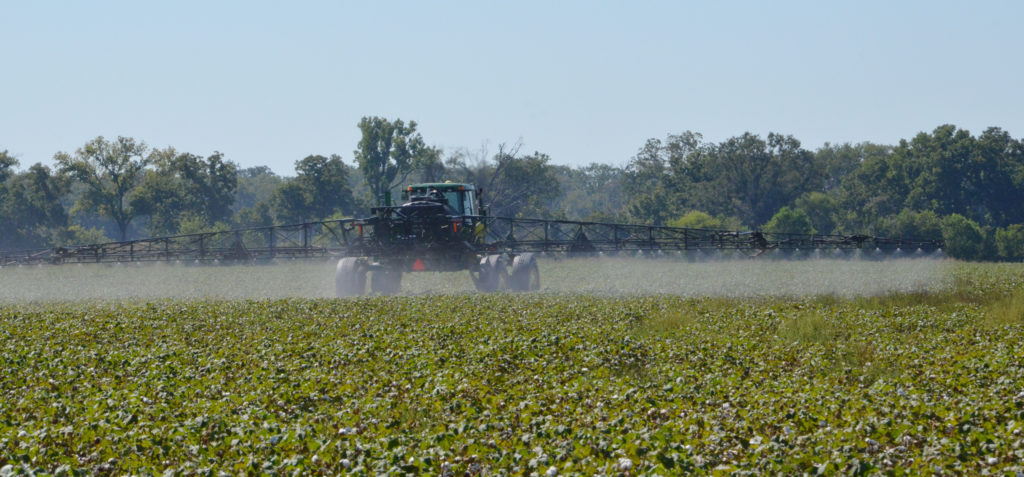You’ve probably seen a lot of talk about Dicamba and 2,4-D in the news lately, particularly if you’re involved in agriculture. I’ve gotten some questions recently about what’s going on with these herbicides and why this is such a major issue now. This two-part series will provide an overview of the need for new herbicide options, the new cotton and soybean traits that have been developed, some concerns and drift issues that have arisen, and what producers can do to protect themselves.
The Need for New Herbicide Options & Traits Developed
Herbicide resistant weeds, particularly those that are no longer killed by pesticides like glyphosate have become a major problem for producers across the country. Instances of weeds like palmer amaranth and other types of pigweed that were not able to be controlled by existing herbicides caused a serious problem for the agricultural industry.
In light of this, chemical and seed companies sought to create crop varieties that were tolerant to different herbicides. Monsanto, BASF, and Dow AgroSciences have developed new herbicides that will combat the resistant weeds. Monsanto developed Xtendimax, BASF developed Engenia, and Dow AgroSciences developed Enlist Duo. The companies are marketing these products as “crop systems” meaning that a farmer purchases the seed that has been genetically modified to be tolerant to the specific herbicide formulation, which the farmer also purchases. So, for example, a farmer would purchase Xtendiflex soybean or cotton seed and XtendiMax with VaporGrip herbicide from Monsanto as a “crop system.”
The Dow AgroScience’s herbicide is a premix of glyphosate (Roundup) and 2,4-D Choline and contains Colex D technology that helps reduced vapor drift and physical drift. The corresponding Enlist soybean and cotton seed is tolerant to this formulation as well to applications of Roundup and Liberty herbicide, meaning that a farmer may spray his field and kill the weeds, while not harming the crop. Similarly, the Monsanto’s Xtendflex cotton will be tolerant to Roundup, Liberty, and the new formulations of dicamba (Xtendimax and Engenia) .
Concerns and Issues
In 2016, both Dow and Monsanto released their seeds for purchase and planting in the United States. However, the EPA had not yet approved the Enlist Duo herbicide, theXtendiMax with VaporGrip, or Engenia for use. This meant that although the seeds were allowed to be planted in the United States, farmers were unable to purchase the corresponding herbicides. However, faced with resistant weed issues, some farmers turned to off-brand or older herbicides containing dicamba and 2,4-D and sprayed these herbicides on their Enlist and XtendiFlex seeds.
What resulted were a number of cases of severe herbicide drift across the country. In Missouri, more than 200 complaints have been filed with the Department of Agriculture related to dicamba herbicide drift since the XtendiFlex seed was released. Drift also occurred in a number of states including Texas. Recently, a class action lawsuit was filed against Monsanto in Missouri federal court by Missouri row crop farmers, seeking to represent a class of other farmers in 10 states (AL, AR, IL, KY, MN, MI, MO, NC, TN, and TX) who suffered the effects of dicamba drift in 2016. Essentially, the plaintiffs claim that Monsanto was willful and negligent in releasing the XtendiFlex seed without EPA approval of the corresponding herbicide, and that Monsanto should have known this would cause the use of other formulations of Ddcamba, causing drift damage. Monsanto has called the lawsuit baseless and explains it as an attempt to impose liability on a company who did not make or sell the herbicide that caused the alleged damage, and in fact warned farmers against the use of any non-Monsanto products over their seeds. [View Complaint here.]
Looking forward to the 2017 growing season, XtendiMax with Vapor Grip, Engenia, and Enlist Duo have all been approved for use by the EPA. While this may cut down on the instances of farmers spraying other dicamba and 2,4-D formulations that are more prone to volatilize, concerns still loom large for a number of reasons. First, there is always the potential for physical movement to occur with any herbicide, especially if care is not used and label instructions are not followed. Second, it is critical that farmers realize that while Enlist seeds are tolerant to 2,4-D Choline and XtendiFlex seeds are tolerant to dicamba, they are not tolerant to the other, meaning that dicamba will kill Enlist crops and 2,4-D Choline will kill XtendiFlex plants. Third, many have expressed concerns about tank-clean out being done properly to avoid incidental exposure to herbicides, but the labels for these products provide a very detailed description of the recommended tank clean out procedures, meaning that contamination from improper tank clean out will likely fall on the applicator rather than the seed/chemical company. Finally, these new herbicide formulations will allow cotton producers to apply product for a much longer time frame in the growing cycle, just further lengthening the time frame during which drift issues could occur.
Stay tuned for Part II when we will discuss some advice for producers (both those using the new crop systems and those who are not) going forward.
*I would like to thank Dr. Peter Dotray, Dr. Jourdan Bell, and Dr. Ed Hellman for their help getting me up to speed about some of the scientific and technical aspects of this post.












